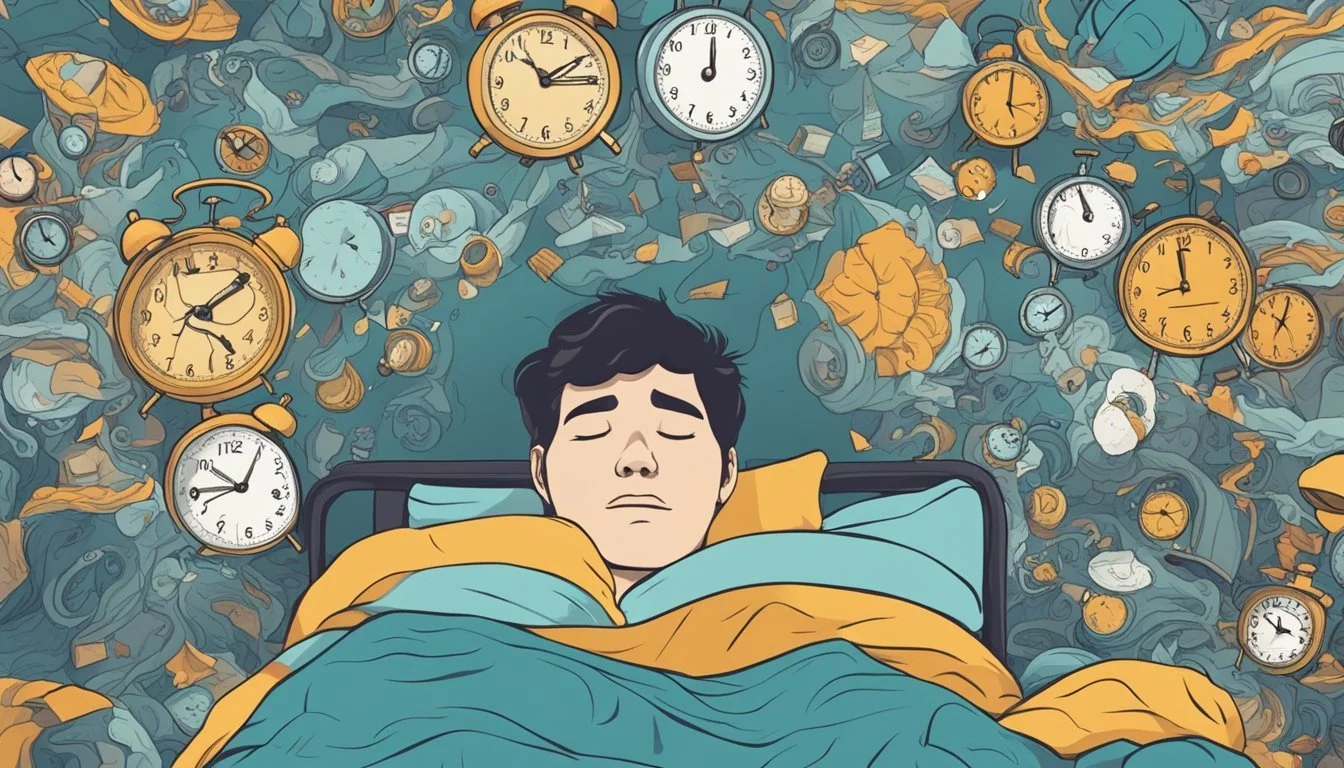5 Differences Between PTSD and Bipolar Disorder
Understanding Key Distinctions
Post-traumatic stress disorder (PTSD) and bipolar disorder are two distinct mental health conditions that often get confused due to some overlapping symptoms. While both can significantly impact an individual's life, understanding the key differences between them is crucial for accurate diagnosis and treatment.
What separates PTSD from bipolar disorder? By exploring their unique features and symptoms, one can gain a clearer perspective on each condition. This article aims to highlight five important differences between PTSD and bipolar disorder, helping readers to better recognize and comprehend these mental health challenges.
1) Mood Swings vs. Emotional Numbness
Mood swings are a central feature of bipolar disorder. Individuals with this condition experience intense highs and lows, ranging from manic episodes to deep depression. These mood swings can last for days or even weeks.
In contrast, emotional numbness is often associated with PTSD. People with PTSD may feel detached from their emotions and surroundings. This numbness can result in a diminished ability to feel pleasure or connect with others.
Unlike the cyclical nature of bipolar mood swings, emotional numbness in PTSD tends to be a chronic state. It can persist for long periods, making it difficult for those affected to engage in daily activities or maintain relationships.
Bipolar mood swings are typically more intense than regular mood fluctuations. They significantly impact daily life and can include risk-taking behaviors during manic episodes and debilitating sadness during depressive episodes.
Emotional numbness in PTSD usually reflects a coping mechanism. It acts as a shield against trauma, reducing the intensity of emotional pain but also limiting positive emotional experiences. This can lead to feelings of isolation and disconnection.
Understanding the difference between these symptoms is crucial for proper diagnosis and treatment. Mood swings in bipolar disorder and emotional numbness in PTSD require different therapeutic approaches tailored to each condition.
2) Consistent Mania vs. Episodic Flashbacks
Mania is a defining feature of bipolar disorder. It involves intense periods of elevated mood, energy, and activity levels. These manic episodes are consistent and cyclic, often followed by depressive episodes.
PTSD, on the other hand, does not involve mania. Instead, individuals with PTSD experience episodic flashbacks. These flashbacks are sudden and involuntary memories of the traumatic event.
Manic episodes in bipolar disorder can last for days or even weeks. They can severely impact daily functioning. Symptoms include increased risk-taking behavior, reduced need for sleep, and grandiose thinking.
Episodic flashbacks in PTSD are triggered by reminders of the trauma. These flashbacks can be brief but extremely distressing. They often disrupt the individual's ability to stay anchored in the present.
The consistency of mania in bipolar disorder contrasts sharply with the unpredictable nature of PTSD flashbacks. While mania follows a more predictable pattern, flashbacks can occur without warning.
Understanding these differences is crucial for proper diagnosis and treatment. Treatment approaches for mania and flashbacks differ significantly, with mood stabilizers often used for bipolar disorder, while therapy and medication targeting trauma responses are used for PTSD.
For more on the differences between these mental health conditions, visit PTSD vs Bipolar.
3) Controlled With Medication vs. Therapy-Centric Approaches
PTSD and bipolar disorder have different treatments in terms of medication and therapy. PTSD treatments often focus on various forms of psychotherapy. Cognitive-behavioral therapy and interpersonal psychotherapy are commonly recommended.
Medications for PTSD are typically used to alleviate specific symptoms rather than as the primary treatment.
For bipolar disorder, medication plays a crucial role in management. Mood stabilizers, antipsychotics, and antidepressants are often prescribed to help regulate the intense mood swings associated with the disorder.
Combining medication with therapy may enhance treatment efficacy for some individuals with PTSD and bipolar disorder, offering a holistic approach.
For more detailed information on therapy versus medication in the context of PTSD, see the guidelines provided by the APA.
To understand the overlapping and distinctive treatment needs of these conditions, explore the Healthline article on PTSD and Bipolar Disorder.
4) Heritable vs. Trauma-Induced
Bipolar disorder is largely considered a heritable condition. Genetic factors play a significant role in its development. Research has shown that individuals with a family history of bipolar disorder are at higher risk of developing the condition themselves.
On the other hand, post-traumatic stress disorder (PTSD) is typically trauma-induced. Individuals develop PTSD after experiencing or witnessing traumatic events. These events can include severe accidents, natural disasters, or violent personal assaults.
While both conditions affect mental health, their origins differ significantly. Bipolar disorder arises more from genetic predispositions. PTSD roots itself in specific external traumatic experiences. This fundamental difference in origins requires distinct approaches in prevention and treatment.
There is some overlap in symptoms, but the causes behind these symptoms diverge. Understanding these origins helps in accurately diagnosing and treating each condition.
Family history is a crucial factor for bipolar disorder, whereas trauma exposure is critical for PTSD. This distinction is essential for clinicians to form an effective treatment plan tailored to the individual’s history and experiences.
For more details on the heritability of bipolar disorder, you can refer to this study.
5) Distinct Sleep Disruptions
Sleep disruptions are a hallmark of both PTSD and bipolar disorder, but they manifest differently.
In PTSD, sleep disturbances often include nightmares and severe insomnia. Individuals may experience frequent awakenings due to nightmares related to traumatic events. This often leads to chronic sleep deprivation and daytime fatigue. Consistent hyperarousal can further exacerbate these disturbances.
Bipolar disorder, in contrast, has variable sleep patterns depending on the mood phase. During manic episodes, there is a significant reduction in the need for sleep. Many patients report sleeping just a few hours while feeling highly energetic. In depressive phases, individuals may sleep excessively or struggle with insomnia.
Understanding these distinct sleep patterns aids in distinguishing between the two disorders. The presence of nightmares and hyperarousal is more indicative of PTSD, whereas fluctuating sleep needs correlate more with bipolar disorder.
Focusing on sleep patterns can improve diagnostic accuracy and treatment outcomes for both conditions. Patients with PTSD may benefit from therapies targeting nightmares, while those with bipolar disorder often need mood-stabilizing medications that also address sleep issues.
Specific interventions tailored to the unique sleep disturbances of each condition can significantly enhance the quality of life for affected individuals.
Overview of PTSD
Post-traumatic stress disorder (PTSD) is a mental health condition triggered by witnessing or experiencing a traumatic event. It manifests through a variety of symptoms including flashbacks, heightened anxiety, and emotional numbness.
Symptoms of PTSD
Individuals with PTSD frequently experience intrusive thoughts or memories of the traumatic event. These often manifest as flashbacks or nightmares. Avoidance behaviors are common as well, where the person avoids places, activities, or people that remind them of the trauma.
Changes in mood and cognition are notable, including negative thoughts about oneself, sustained negative emotional states, and a lack of interest in previously enjoyed activities. Arousal-related symptoms such as being easily startled, feeling tense, or having difficulty sleeping are also prevalent.
Common Triggers
Triggers for PTSD can vary widely from person to person. Sensory reminders such as loud noises, specific smells, or certain sights can bring back the trauma. Anniversary dates and locations associated with the traumatic event can also act as triggers.
Emotional responses such as feeling distressed by news reports or witnessing similar events can exacerbate symptoms. Personal relationships and significant changes in one's life, even positive ones, may trigger PTSD symptoms.
Diagnosis Criteria
The diagnostic criteria for PTSD include experiencing or witnessing a traumatic event, along with persistent intrusive symptoms like flashbacks or nightmares. Avoidance behaviors and changes in mood or cognition, such as ongoing negative thoughts, must be present.
Arousal and reactivity symptoms like hypervigilance or irritability are also critical. These symptoms must persist for more than a month and cause significant distress or impairment in social, occupational, or other important areas of life.
Overview of Bipolar Disorder
Bipolar disorder is a mental health condition characterized by significant mood swings, including manic highs and depressive lows. It can affect one's ability to function in daily life and often requires long-term treatment.
Symptoms of Bipolar Disorder
Bipolar disorder involves manic and depressive episodes. During manic episodes, individuals often experience increased energy, euphoria, or irritability. They might engage in risky behaviors, have racing thoughts, and exhibit reduced need for sleep.
Depressive episodes are marked by feelings of sadness, hopelessness, and fatigue. Individuals may lose interest in activities, experience changes in appetite or sleep, and have difficulty concentrating. Symptoms can vary from mild to severe and may significantly impact daily functioning.
Types of Bipolar Disorder
There are several types of bipolar disorder, each with distinct patterns of mood episodes:
Bipolar I Disorder: Characterized by manic episodes lasting at least seven days or severe mania requiring hospital care. Depressive episodes usually occur as well, typically lasting at least two weeks.
Bipolar II Disorder: Defined by a pattern of depressive and hypomanic episodes, which are less severe than full manic episodes.
Cyclothymic Disorder: Involves periods of hypomanic and depressive symptoms that last for at least two years but are less severe than those of bipolar I or II.
Other Specified and Unspecified Bipolar Disorders: These include bipolar symptoms that do not match the three categories above.
Diagnosis Criteria
Diagnosing bipolar disorder involves a thorough evaluation by a mental health professional. The process typically includes:
Clinical Interview: Discussing symptoms, family history, and any previous episodes of mood disturbance.
Mood Charting: Tracking mood changes over time to identify patterns.
DSM-5 Criteria: Meeting specific criteria outlined in the Diagnostic and Statistical Manual of Mental Disorders (DSM-5). For bipolar I, this requires at least one manic episode. Bipolar II requires at least one hypomanic and one depressive episode.
Physical Exam: Ruling out other medical conditions that might cause mood swings, such as thyroid problems or neurological issues.
Each type of bipolar disorder has specific diagnostic requirements to ensure accurate identification and appropriate treatment.
Treatment Options
The treatment for PTSD and Bipolar Disorder varies significantly. Each condition requires a tailored approach, comprising therapies and medications specific to the symptoms and patterns observed in the patient.
Therapies for PTSD
PTSD therapies often include Cognitive Behavioral Therapy (CBT), which helps individuals reframe negative thought patterns. Another common approach is Exposure Therapy, where patients gradually face their trauma-related memories and situations in a controlled environment.
Eye Movement Desensitization and Reprocessing (EMDR) is another effective method. It involves guided eye movements that help patients process and integrate traumatic memories.
Group therapy and support groups can also be valuable, providing communal support and understanding. Patients benefit from sharing experiences and coping strategies in a safe, therapeutic setting.
Therapies for Bipolar Disorder
Therapies for Bipolar Disorder typically focus on Psychoeducation, helping patients understand their condition and recognize mood episode triggers. Cognitive Behavioral Therapy (CBT) is used to address negative thought patterns and develop coping strategies.
Interpersonal and Social Rhythm Therapy (IPSRT) is another approach. It aims to stabilize daily routines and social rhythms, which can help manage mood swings.
Family-focused therapy involves the patient’s family and educates them about the disorder, improving familial support and communication. This approach can be crucial in creating a supportive home environment for the patient.
Medications
Managing these conditions often requires medication. For PTSD, some common medications include Selective Serotonin Reuptake Inhibitors (SSRIs) such as sertraline and paroxetine. These help alleviate anxiety and depression associated with PTSD.
In Bipolar Disorder, mood stabilizers like lithium and anticonvulsants such as valproate are widely used. Atypical antipsychotics like olanzapine and quetiapine can manage both manic and depressive episodes.
Combining psychotherapy with medication often yields the best outcomes. Regular follow-ups and consultation with healthcare providers ensure that the treatment plan is effective and adjusted as needed.







